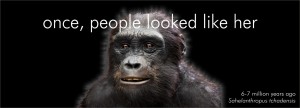 I’ve never wanted nor pretended to be a biologist. I prefer to blame this possible character flaw on the fact I never liked dissecting animals, or the smell of formaldehyde.
I’ve never wanted nor pretended to be a biologist. I prefer to blame this possible character flaw on the fact I never liked dissecting animals, or the smell of formaldehyde.
My approach to science has always been “need to know” — meaning if I decide that I need to know something, I’ll put a little effort into figuring out how it works.
In the years since graduating from college I have certainly learned how to make children and grandchildren. For the longest time, I felt like that was enough knowledge of biology to satisfy my curiosity; I knew how to do my part to perpetuate of the species, and that was all I thought I needed to know.
When these evangelists for atheism like Richard Dawkins began using their belief in evolution as justification for attacking belief in the existence of a creator God, I decided it was probably time for me to learn a bit more about this theory used to justify their claims of having eliminated the possibility that a supernatural God could exist.
The Business Dictionary provides an excellent definition that I like which describes information as “Data that is (1) accurate and timely, (2) specific and organized for a purpose, (3) presented within a context that gives it meaning and relevance, and (4) can lead to an increase in understanding and decrease in uncertainty.”
As a former professional software developer, that definition seems both useful and apropos. Computers accept raw data as input. Software applications inside the computer process that raw data to convert it into useful information.
The key phrase in the definition was “specific and organized for a purpose.”
DNA is very compacted, specific information– genetic raw data is processed by organic cells and turned into information exponentially more complex than computer machine language.
The best analogy I can think for DNA is that it seems to be a perfectly blended recipe comprised of four nucleotides organized into specific sequences to produce one unique living organism of the same species as the parents — we know from experience that hybrid animals are biological dead ends.
However, advocates of evolution theory typically take a dim view of criticism. They will vociferously object to the idea of intelligent design being offered as an alternative for evolution theory.
Dr. Ken Miller has openly said that he believes people like me who have raised questions about the theory of evolution are motivated by bias toward religion and belief in the supernatural rather than scientific curiosity.
I would respond to that accusation that my stubbornness stems from the inability of experts such as him to answer my questions, which admittedly pose challenges the theory of evolution.
And before I swallow Darwin’s theory hook, line, and sinker, I need to know what mechanisms allow physical transformation that could most easily be described incredible shapeshifting that allegedly takes over many generations — the transformations necessary to evolve from apes to men must be nothing short of spectacular.
Nevertheless, I have frequently been accused by my critics of being too dumb to understand the theory of evolution, which strikes me as a relatively simple concept. Given enough sex, isolation, and time, monkeys can allegedly evolve into men.
I’ve learned to consider the source, and to take into account that that the most obnoxious and personal insults come from less well-educated people and frequently contain numerous grammatical errors and misspelled words. My thirst for knowledge exceeds my ego. I’m willing to swallow my pride and risk the wrath of my critics to make myself clear. It also helps that more intelligent people like Dr. Miller tend to be very courteous and respectful, so risking the potential embarrassment of asking the question often proves to be well worth the effort.
My response to my critics is always the same: my inability to understand how the theory of evolution works in the real and observable world to cause the origin of new species certainly hasn’t been for the lack of trying.
What biological process(es) other than sex, isolation, and time, might exist that allows monkeys to turn into men? It seems we are missing a critical piece to the Big Picture puzzle.
I’ve read a lot of books on evolution theory, including The Greatest Show on Earth: the Evidence for Evolution by Richard Dawkins, and of course Jerry Coyne’s book Why Evolution is True, in my attempts to understand the theory of evolution — yet my fundamental “how did it happen?”questions have remained unanswered to my satisfaction.
Evolution theory isn’t a terribly complicated concept, in my opinion. It may be summed up using only three words: descent with modification.
According to this theory, because you don’t appear to be clones of your parents or grandparents, you may safely assume that several million years ago, your ancestors were apes. Not modern apes, of course. Extinct, common ancestor apes that we know weren’t gorillas, chimpanzees, orangutans, even though we don’t know what they were.
My problems with this theory of evolution are fairly simple and straightforward: if humans evolved from apes, how did this happen? And if every living organism is related through descent by sex, isolation, and time, then we are cousins to all plants and animals on Earth.
So here we go, one more time: apes have 24 pair of chromosomes (48 total.)
Humans have 23 pair, or 46 total chromosomes. a mismatch in count.
About ape-to-human evolution Dr. Miller has said,
If a whole primate chromosome was lost, that would be lethal. So there’s only two possibilities. And that is, if these guys (chimpanzees, gorillas, orangutans, and humans) really share a common ancestor, that ancestor either had 48 chromosomes or 46.
Nevertheless it seems to be quite logical to assume that at some point in time, a living organism with 48 chromosomes must have given birth to an organism with only 46, if we’re going to work from the assumption that humans descended from other primates.
After reading those books and many others on evolution theory, I published open letters written to biologists Jerry Coyne, Francis Collins, and Ken Miller so that I might also learn why design is considered inconceivable and descent believed without question.
Replies from Dr. Miller and a response that came from Dr. Benoit LeBlanc on behalf of biology professors (in lieu of Dr. Coyne) were published in unexpurgated form.

My question remains simple: how did humans really descend from creatures that resembled the one as claimed in the picture to the right?
According to the theory of evolution, the answer is simply sex, isolation, and time.
In this video Dr. Miller said,
What must have happened is that one pair of chromosomes must have gotten fused. We should be able to look at our genome and discover that one of our chromosomes resulted from the fusion of two primate chromosomes. So we should be able to look around our genome and you know what? If we don’t find it, then evolution is wrong, and we don’t share a common ancestor.
When I wrote Dr. Miller to question his use of the word “fusion” to describe the joining of two chromosomes, he assured me that the word was appropriate, though the official biological term for the phenomena was a “Robertsonian translocation.”
A little research on Robertsonian translocations taught me the following:
- Robertsonian translocations are rare mutations caused by the fusion of two chromosomes in offspring created by sexual reproduction.
- Most cases of Robertsonian translocations are either harmful or fatal to offspring (trisomy 13 (Down), trisomy 21 (Patau), and Edwards syndromes.)
- In the event of “balanced” Robertsonian translocations, the individual is not harmed because no genetic information has been gained or lost.
- Variations in the number of chromosomes caused by fusion does not create a new species. There is a healthy human male allegedly discovered to only have 44 chromosomes, but in reality chromosomes 14 and 15 merely joined together. Nevertheless, the article found at the Stanford Tech Review reported that the man’s “chromosomes are arranged in a stable way that could be passed on if he met a nice girl who had 44 chromosomes too. And this would certainly be possible in the future given his family history.”
But how could this this possible?
If this man can’t produce viable offspring with anyone except a “nice woman” with a matching count of 44 chromosomes (presumably with the same two chromosomes fused), how could we ever have a new species of humans that only have 44 chromosomes?
If these traits are both rare and undetectable within members of a population, how do the “44s” know to pair together in order to produce viable offspring?
Before I can believe evolution is true, I need to know how these things could happen.
This article was titled Why evolution theory is probably false for these reasons:
- Robertsonian translocations are rare events, and usually detrimental or fatal.
- Genetic information cannot be added or subtracted to an existing genome without causing the offspring serious harm.
- Robertsonian translocations do not cause the origin of a new species. Therefore, if translocations have no relationship to the origin of new species, then any examples of an apparent translocation between two species could only be coincidence or illusion.
- The primary feature of other genetic abnormalities such as Klinefelter syndrome is sterility.
- The title of Jerry Coyne’s book is Why Evolution is True, but I don’t think it is true. I’m allowing for the possibility that I might be wrong, however.
Evolution theory tells us that unguided and unintelligent processes gradually transformed less intelligent animals into more sophisticated creatures, including from apes to human beings simply through sex and isolation, given the vagaries of time.
The “experts” can produce evidence that they claim “proves” species have originated in this way, but they don’t have the foggiest idea how it possibly could have happened. The ape on the right above had to have mated with a male ape that looked like her and matched her genetics. There’s nothing I’ve discovered in biology that might explain why their descendants would ever look significantly different.
Genetic material cannot be accurately described as information until it has been processed according to specific rules by an intelligent application to produce meaningful results.
Otherwise you end up with useless gibberish.
[hat tip to Maurice D. for posting the YouTube video featuring Dr. Ken Miller titled “How to Shut Up Pesky Creationists” that inspired this article.]

Speak Your Mind